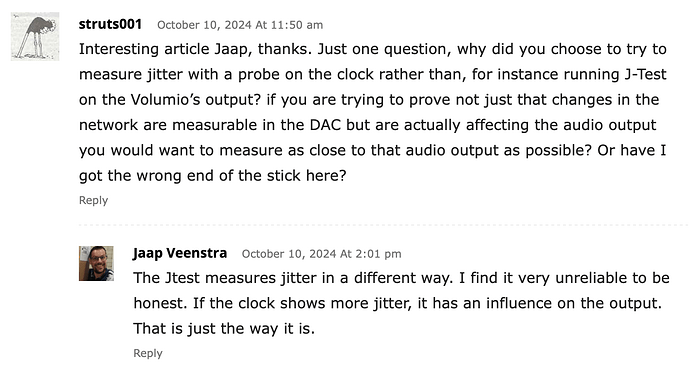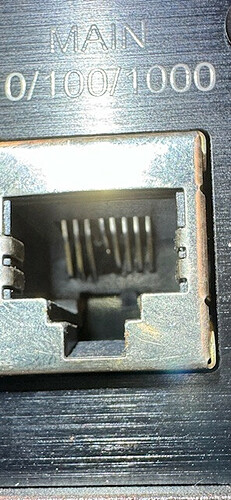Another interesting read from one of my favourite audio websites:
Nice to see some objective proof of what my ears have told me and why I spent more in this area this year.
For this little study, we took out the Volumio Primo again and placed it in the RF-shielded measurement box. We used the Volumio’s standard power supply. On the 100 MHz crystal we placed an active probe. This probe sends the clock signal to the Aeroflex. As a reference, we connected the Axtal 100 MHz crystal.
So, if I understand correctly, rather than measuring the analog output of the Volumio Primo Streamer/DAC for any consistent differences, they instead measure jitter on an intermediate internal clock?? Why not measure the closest proxy to what they actually hear??![]()
Reminds me of the parable of the six blind men and the elephant ![]()
And why the Volumio Primo? Have you looked at the internals of that thing? The ASUS Compute board sits practically ontop of the DAC. Can’t they get a bettered engineered product that suits the Audiophile space they’re trying to address?
Thanks struts. The fact that they finds J-Test “unreliable” basically tells us everything we need to know ![]()
That said, every Ethernet Switch will demonstrate differences in noise and packet jitter profiles, that’s a given. The difference are typically caused by power and clocking component differences, as well as Switch chipset associated firmware differences that drive variation in packet queuing. So, when measuring the digital side of things, it can very well manifest as consistent measurable differences between Ethernet Switches.
However, in a adequately designed Streamer/DAC, the digital input stage can quite easily be well isolated, not just via the packet reassembly/buffering/synchronous play-out of the PCM/DSD streams, but also by having proper power regulation/separation so that those incoming jittery packet streams & noise have no chance of causing any sonic impact.
Take a look at the Volumio Primo’s internals; it’s basically a DAC board HAT (Hardware Attached on Top) for an Asus Tinkerboard Single-Board-Computer. While there appears to be an isolator chip and power regulator chips, those are directly on the DAC board, and the whole thing has a single power supply. Hardly the sort of platform to use if AA wants to be taken seriously IMHO.
I’ve felt for many years that there is a certain irony that Ethernet - which is overall a really well thought out and inherently extremely rugged protocol - can be so effectively and enthusiastically “tweaked” into being unreliable by the application of some generally quite expensive “specialist” boxes and cables - I even did a presentation on this for “Clarity”, the UK HiFi Dealers Association, at their yearly big meeting at the Dolby building in London back in 2019…
Just for your interest this is a recent victim of a “specialist” network cable that we had through the doors…
![]()
![]()
![]()
![]()
![]()
![]()
![]()
![]()
![]()
![]()
I just thought that I would remark on the subject of expensive network devices that Melco has recently announced the S1. €13,999. Not a DAC, not a streamer but a network switch. ![]()
Oh, forgot I’m a bit of a Melco fan. Better order one then …
Yikes! ![]()
Too true. And we can see both ends of the spectrum; manufacturers who imagine they can just slap Ethernet electronics onto an analog platform willy nilly, and the other end with gratuitous OTT designs that perpetuate audiophile myths around Ethernet and associate analog like characteristics to what’s essentially a software paradigm.
In any case, these days the level of hyperbole and absurdity associated with Ethernet within the Audiophile community is absolutely insane. The loony rabbit hole can go quite deep. $500 Audiophile SATA cables anyone?
Ah yes … I remember that one … ![]()
P
I recently bought a Schnerzinger LAN cable, replacing my Tellurium Q Silver (before that Chord, before that Furutech, before that Melco, before that…I forgot…).
This stupid white cable brought more SQ in my stereo than some 10000€ upgrades I did.
My Rossini plays now like a top full-spec LP12, analog in every way, breathtaking in every aspect. After that, I will not change my speakers (new speakers were on my shopping list.)
Even my wife was shocked (well, she was very upset because I spend cash for cables again, but then she asked after listening: you really changed only a cable? )
Network switches and cables do matter- I proved it the hard way €€€€€ ![]()
This thread is about hard evidence. That means objective, verifiable evidence. I am pleased for you that you are enjoying your cables but in the context of hard evidence it’s not moving us forward. As you know I am of the opinion ( and it is no more) that the execution of the network impacts the result heard ( beyond simple functionality). However I think we are looking for evidence that helps to unarguably verify any effect and which explains why.
The Schnerzinger LAN cable: 100% of its conductor has ATOMIC BONDING!
There are three basic ways that the outer electrons of atoms can form bonds:
- Electrons can be transferred from one atom to another
- Electrons can be shared between neighbouring atoms
- Electrons can be shared with all atoms in a material → This is called the metallic bond and, as the name implies, it is what holds metals together.
So, as it seems, its conductor is made of metal. Now is that special, or not? ![]()
It’s like always…one half says it can’t sound because we can’t measure it!
the other half says it doesn’t matter what measurements, the main thing is that it sounds good.
I’m part of the camp that trusts his ears.
A Burmester has ideal measurements and still sounds boring (imho). An Audio Note CD player sounds great, the measurements are mediocre…who is right?
I also note they (Schnerzinger) have developed the concept of a ‘Bidirectional barrier’. I think this may be… yes… insulation! I was so excited I didn’t stop to read the details (if any). So we now have metal, and we also have insulation. Yes indeed, the ingredients of a cable. Oh, boy.
yes, my dealer told me that they are sponsored (R&D) by the military industry- so bad are they…
give a shit what they write- just listen ![]()
Yes, or rather it was about the linked Alpha Audio article that was claiming the same but IMO not delivering. It seems to me that by demonstrating some correlation between network jitter and clock jitter what they are providing is circumstantial evidence of a correlation with playback quality. I challenged the author on this and you will see the resulting exchange in the comments after the article. I am surprised by their assertion that J-test is unreliable and that is something I want to get to the bottom of. I applaud Alpha’s attempts to actually back listening impressions with relevant measurements here but I think “hard” is a bit of an overstatement.
With the arrival of an aurender W20SE I no longer experience added value from my Uptone EtherRegen, Ultracap LPS 1.2 & AQ diamond RJ/E. I’ve pulled it out of the chain, having a cheap network cable now direct into the Aurender …that is to say almost direct, still use a Pink Faun Lan Isolator but hey, that’s only a plug ![]()
At the end of the day as long as someone has auditioned “Brand X” and feels that in their system “Brand X” makes an appropriate difference for the money that it costs then I have absolutely no issues with that and it’s not my place to try to tell anyone whether you should or shouldn’t spend your money in a certain way…
…however…
…if a bit of kit gets introduced into a system that “sounds spectacular” but it causes the underlying fabric that the system depends on to either become unreliable (in so much that it - say - blocks UDP / SSDP discovery so autodiscovery no longer works or causes intermittent dropouts) or causes physical damage (as above) then that is an issue and this is where I have a problem.
I’ve had many emails over the 20+ years that I’ve been doing this saying “I’ve added a <insert_widget_name_here> to my setup and it sounds amazing but <something_that_used_to_work_perfectly> now isn’t working … it’s vital that you fix this” and it seems poorly understood that a network device doesn’t just “see” everything else on the network.
(There have been a couple of instances of this discussed on the forum previously…)
In reality a device on a network only “sees” the data that comes into it along the wire that is connected to it - think of it as being in a room that only has a doorway and although the room is illuminated everything beyond the doorway is simply inky-blackness… (Of course I now have to try to get “veils” into this analogy if I can don’t I?)
If two devices used to be able to “talk” to each other or discover each other on a network and no longer can do then “we” can’t magically program a way around that into our kit and quite often when I ask for a newly installed piece of network kit (be it a cable or a switch or a network extender) to be removed and the old configuration restored so that we can start to diagnose what’s going on then there’ll be quite a push back (to the extent of outright refusal in some cases) to doing so.
So yes, “tweaking” is all well and good but it is very easy to “tweak” yourself into an unreliable network whereas it isn’t possible to “tweak” yourself into a reliable network…



